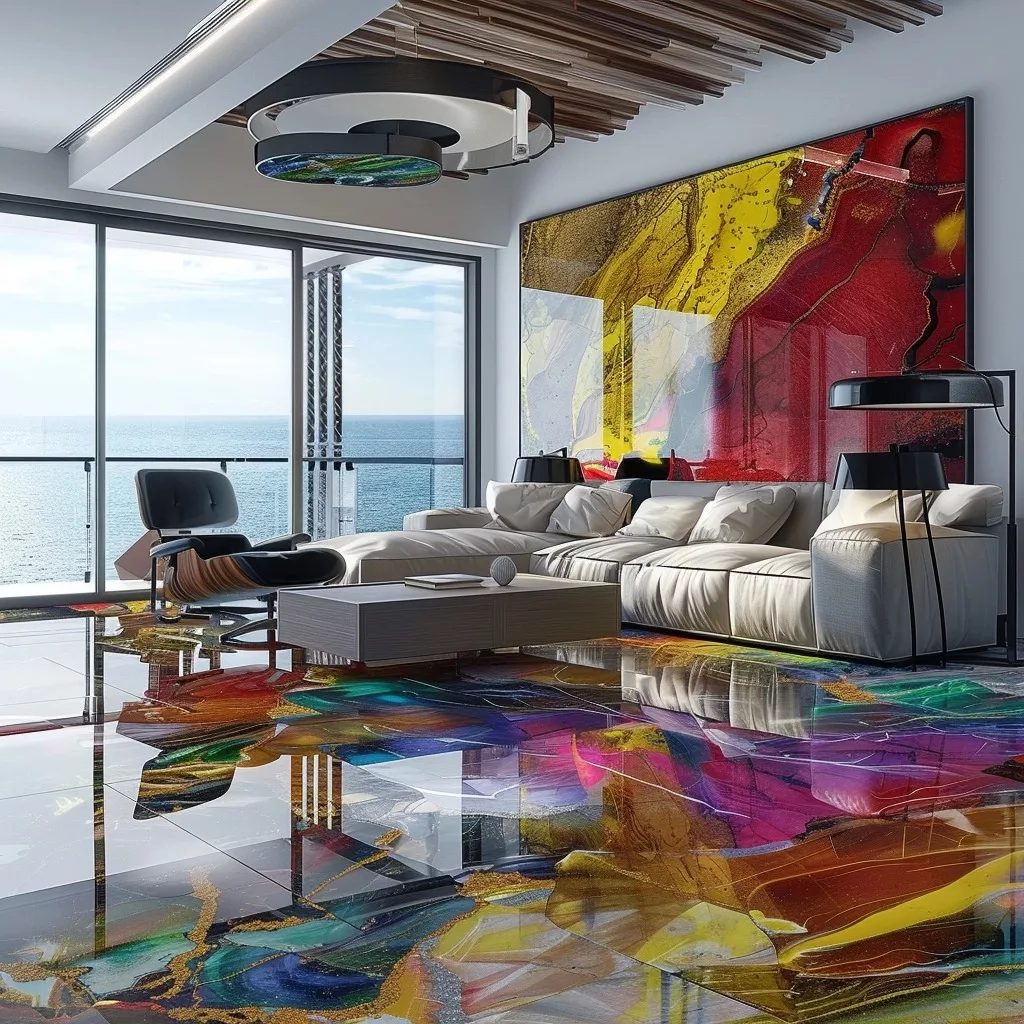
Colorful ammolite stone pattern floor. In the world of architecture and interior design, the search for unique and captivating materials is a never-ending pursuit. Among the plethora of gemstones and decorative elements available, ammolite stone stands out as a mesmerizing and versatile choice. With its vibrant colors, iridescent patterns, and exceptional durability, ammolite has emerged as a sought-after material for flooring, countertops, and decorative accents.
Contents
- 1 What is Ammolite?
- 2 The Beauty of Colorful Ammolite Stone
- 3 Ammolite Stone Patterns
- 4 Flooring Options with Ammolite Stone
- 5 Solid Ammolite Stone Tiles
- 6 Ammolite Stone Mosaic Tiles
- 7 Ammolite Stone Slabs
- 8 Benefits of Using Ammolite Stone for Flooring
- 9 How to Care for Ammolite Stone Floors
- 10 Choosing the Right Colorful Ammolite Stone Pattern for Your Floor
- 11 Cost and Installation of Ammolite Stone Flooring
- 12 Conclusion
What is Ammolite?
Ammolite is an iridescent gemstone formed from the fossilized shells of ancient marine creatures called ammonites. These creatures lived in the seas millions of years ago and their shells were gradually transformed into a crystalline structure known as ammolite as they decomposed. This process takes millions of years and results in a stone with remarkable optical properties.

The Beauty of Colorful Ammolite Stone
The most captivating feature of ammolite is its unparalleled range of colors. When light strikes the stone’s microscopic crystals, it refracts and diffracts, creating a mesmerizing play of colors that mimics the hues of the rainbow. From fiery reds and golden yellows to incandescent blues and emerald greens, ammolite offers a symphony of colors that can enhance any space.

Ammolite Stone Patterns
In addition to its vibrant colors, ammolite is also known for its intricate patterns. These patterns are a result of the layers of aragonite crystals that make up the stone. As the stone forms, these layers can shift and create unique patterns that add to the overall beauty of the stone. Some common patterns found in ammolite include:
- Streaked: This pattern features streaks of different colors running through the stone, creating a dynamic and eye-catching effect.
- Mosaic: In this pattern, the stone resembles a mosaic with small, colorful pieces coming together to form a larger picture.
- Flame: As the name suggests, this pattern resembles a flame with vibrant colors radiating from a central point.
- Peacock: This pattern is characterized by a mix of blue, green, and purple hues that resemble the feathers of a peacock.

Flooring Options with Ammolite Stone
Ammolite stone can be used in a variety of ways in flooring. Its durability and unique beauty make it a popular choice for both residential and commercial spaces. Here are some options for using ammolite stone in flooring:

Solid Ammolite Stone Tiles
Solid ammolite stone tiles are a popular choice for flooring as they offer a seamless and elegant look. These tiles are cut from a single piece of ammolite and come in various sizes and patterns. They can be installed in any room and are particularly suitable for high-traffic areas such as hallways and entryways.

Ammolite Stone Mosaic Tiles
For a more intricate and eye-catching look, ammolite stone mosaic tiles are an excellent option. These tiles are made up of small pieces of ammolite arranged in a specific pattern to create a larger design. They can add a touch of luxury and sophistication to any space and are often used in bathrooms and kitchens.

Ammolite Stone Slabs
For larger spaces or outdoor areas, ammolite stone slabs are a great choice. These slabs are cut from a single piece of ammolite and can cover a larger area without any visible seams. They are also a popular choice for outdoor patios and walkways due to their durability and resistance to weathering.

Benefits of Using Ammolite Stone for Flooring
Aside from its stunning appearance, ammolite stone offers several benefits when used for flooring. These include:
- Durability: Ammolite stone is incredibly durable and can withstand heavy foot traffic without showing signs of wear and tear.
- Low Maintenance: Unlike other types of flooring, ammolite stone requires minimal maintenance. Regular sweeping and mopping are enough to keep it looking pristine.
- Hypoallergenic: Ammolite stone is non-porous, making it resistant to bacteria and allergens. This makes it an ideal choice for those with allergies or respiratory issues.
- Eco-Friendly: As ammolite stone is a natural material, it is an eco-friendly option for flooring. It does not emit any harmful chemicals and can be recycled at the end of its lifespan.

How to Care for Ammolite Stone Floors
To ensure that your ammolite stone floors retain their beauty and durability, it is essential to follow proper care and maintenance practices. Here are some tips to keep in mind:
- Regular Cleaning: Sweep or vacuum your ammolite stone floors regularly to remove any dirt or debris. Use a damp mop with a mild soap solution to clean the surface.
- Avoid Harsh Chemicals: Harsh chemicals can damage the surface of ammolite stone, so it is best to avoid using them for cleaning. Stick to mild soap solutions or specialized stone cleaners.
- Wipe Up Spills Immediately: As ammolite stone is porous, it can absorb spills and stains if left unattended. Wipe up any spills immediately to prevent staining.
- Use Protective Mats: Place mats at entryways and high-traffic areas to prevent dirt and debris from scratching the surface of your ammolite stone floors.
- Reseal When Necessary: Depending on the type of sealant used, ammolite stone floors may need to be resealed every few years. Consult with a professional to determine the best schedule for resealing.

Choosing the Right Colorful Ammolite Stone Pattern for Your Floor
With its wide range of colors and patterns, choosing the right ammolite stone pattern for your floor can be a daunting task. Here are some factors to consider when making your selection:
- Room Size: The size of the room can play a significant role in determining the pattern of ammolite stone you choose. For smaller rooms, opt for lighter colors and simpler patterns to avoid overwhelming the space.
- Existing Decor: Consider the existing decor and color scheme of the room when choosing an ammolite stone pattern. You want the flooring to complement the overall design rather than clash with it.
- Personal Preference: Ultimately, the pattern you choose should be one that you love and will enjoy seeing every day. Trust your instincts and go with a pattern that speaks to you.

Cost and Installation of Ammolite Stone Flooring
The cost of ammolite stone flooring can vary depending on factors such as the type of stone, pattern, and installation method. On average, solid ammolite stone tiles can range from $50-$100 per square foot, while mosaic tiles and slabs can cost upwards of $150 per square foot. The installation process can also add to the overall cost, so it is essential to consult with a professional for an accurate estimate.

Conclusion
In conclusion, ammolite stone is a stunning and versatile material that can add a touch of luxury and uniqueness to any space. Its vibrant colors, intricate patterns, and durability make it a popular choice for flooring, countertops, and decorative accents. With proper care and maintenance, ammolite stone floors can last for decades, making it a worthwhile investment for any home or commercial space. So why settle for ordinary flooring when you can have the beauty and elegance of colorful ammolite stone patterns under your feet?












